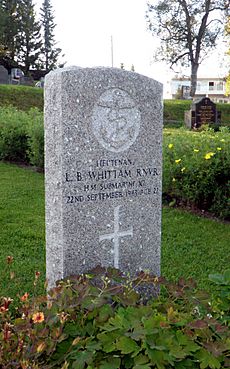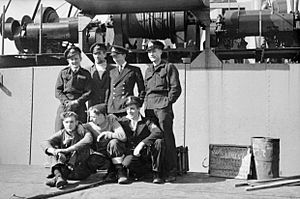Operation Source facts for kids
Quick facts for kids Operation Source |
|||||||
|---|---|---|---|---|---|---|---|
| Part of World War II | |||||||
 Tirpitz circa 1941 |
|||||||
|
|||||||
| Belligerents | |||||||
| Commanders and leaders | |||||||
| Henty Henty-Creer † | Hans Meyer | ||||||
| Strength | |||||||
| Six midget submarines, Six conventional submarines |
Two battleships, One heavy cruiser |
||||||
| Casualties and losses | |||||||
| Five midget submarines sunk, ten crewmen killed, six captured | One battleship damaged | ||||||
Operation Source was a secret plan during World War II. Its goal was to damage or stop powerful German warships like the battleship Tirpitz, the battleship Scharnhorst, and the heavy cruiser Lützow. These ships were hiding in the fjords of northern Norway. The attacks used special, very small submarines called X-craft or midget submarines.
The attacks happened in September 1943 in a place called Kaafjord. They were a success because they kept the Tirpitz out of action for at least six months. This was a big win for the Allies. The idea for this daring mission came from Commander Cromwell-Varley. He had the support of Max Horton, who was in charge of submarines, and even Prime Minister Winston Churchill.
The entire operation was planned and managed from a place called HMS Varbel. This base was located in Port Bannatyne on the Isle of Bute in Scotland. Varbel was once a large, fancy hotel. It was taken over by the navy to be the main headquarters for the 12th Submarine Flotilla, which was the group of midget submarines. All the training for the X-craft crews and the planning for attacks, including the one on Tirpitz, happened here.
Important information that helped the Royal Navy plan the attack on Tirpitz came from the Norwegian resistance. These brave people, especially brothers Torbjørn Johansen and Einar Johansen, secretly collected and sent details about the German ships.
The Daring Attack
Six X-craft submarines were chosen for this mission. Three of them, X5, X6, and X7, were assigned to attack the huge battleship Tirpitz in Kåfjord. Two others, X9 and X10, were meant to attack the battleship Scharnhorst, also in Kåfjord. The last one, X8, was tasked with attacking the heavy cruiser Lützow in Langfjord.
These tiny submarines couldn't travel all the way to Norway on their own. So, bigger, regular submarines towed them most of the way. Special "passage crews" were on board the X-craft during the tow. Once they got close to the target area, the main "operation crews" would take over.
Sadly, not all the X-craft made it. X9 was lost with all three of its crew members during the tow. It seems the heavy seas caused its tow rope to break, and it sank quickly. X8 also ran into trouble. It developed serious leaks in its special demolition charges, which were attached to its sides. The crew had to release these charges, and they exploded. This damaged X8 so badly that it had to be sunk by its own crew.
The remaining X-craft began their final approach on September 20. The actual attacks happened on September 22, 1943, starting at 7:00 pm. The Scharnhorst was out doing exercises and wasn't at its usual spot. Because of this, and some mechanical and navigation problems, X10's attack was called off. X10 tried to return to its towing submarine but was later sunk by its crew when the tow rope broke again on the way back to Scotland.
X5, commanded by Lieutenant Henty-Creer, disappeared during the operation. It's believed that Tirpitz's guns hit and sank X5 before it could place its charges. There's a small chance X5 did manage to drop its charges, but this was never fully proven.
X6 and X7 were successful. They managed to drop their powerful demolition charges right underneath the Tirpitz. However, they were spotted and attacked by the Germans. Both submarines were abandoned, and six crew members were captured. When they were captured, the brave crewmen told the German captain, Hans Meyer, that explosions would happen under Tirpitz within an hour. Meyer quickly tried to move the huge ship away, but it was too late.
The Tirpitz was badly damaged by the explosions. It didn't sink, but it took on over 1,400 tons of water. It also suffered major damage to its engines and other parts. The explosions ripped holes in its hull and bent parts of its structure. Many of its generators were broken, and one of its main gun turrets was knocked off its bearings. This was a huge problem because there were no cranes in Norway big enough to fix it. Even the ship's two small seaplanes were completely destroyed by the blast.
Repairs to the Tirpitz were carried out by a German repair ship called Neumark. Historians have called this repair effort "one of the most notable feats of naval engineering during the Second World War." The repairs took a long time, lasting until April 2, 1944. However, the Tirpitz was finally destroyed by Avro Lancaster bombers on November 12, 1944.
For their incredible bravery in this action, the commanders of X6, Lieutenant Donald Cameron, and X7, Basil Place, were awarded the Victoria Cross. This is the highest military award for bravery in the United Kingdom. Other crew members also received high honors for their courage.
The Brave X-Craft Crews

Here are some details about the X-craft and the brave people who served on them:
- X-5: This submarine was unofficially called Platypus. It was commanded by Lt. Henty Henty-Creer. The crew included S-Lt Nelson, Midshipman Malcolm, and ERA Mortiboys. All of them were killed during the attack, and the exact fate of X-5 is still unknown.
- X-6: Named Piker II, this X-craft was commanded by Lt Donald Cameron. His crew included Lt J. T. Lorimer, S-Lt. R. Kendall, and ERA Goddard. Lt. Cameron earned a Victoria Cross (VC) for his bravery. Lorimer and Kendall received the Distinguished Service Order (DSO), and Goddard earned a Conspicuous Gallantry Medal (CGM).
- X-7: Unofficially named Pdinichthys, this submarine was commanded by Lt Basil Place. His crew included S-Lt Aitken, Lt Whittam, and ERA Whiteley. Lt. Place also earned a Victoria Cross (VC). Aitken received the Distinguished Service Order (DSO). Sadly, Whittam and Whiteley were killed in the attack.
- X-8: This X-craft was commanded by Lt McFarlane of the Royal Australian Navy.
- X-9: Commanded by Lt Martin of the Royal Navy, this submarine sank on September 16, 1943.
- X-10: Unofficially named Excalibur, this X-craft was commanded by Lt Hudspeth of the Royal Australian Naval Volunteer Reserve.
See also
- XE-class submarine


